What is a WordPress theme framework?
A theme framework is a set of files used to develop WordPress themes. A theme framework acts as a foundation when building a new WordPress theme — it handles basic theme functionality and design, and comes with a set of standards and customization options that allow developers to build a tailored theme on top of it.
Even if you aren’t familiar with theme frameworks, there’s a chance you’ve used a WordPress theme that was built with one. Many WordPress theme companies develop a theme framework, then create themes as variations of this central theme framework — Themify and StudioPress are examples.
There are also lots of developers that create themes using someone else’s framework. WordPress theme developers like the framework-based approach because it both reduces workload and provides a strong foundation to publish new themes regularly with small modifications. Theme frameworks let you make your own WordPress theme without starting from scratch.
How do WordPress theme frameworks work?
To use a WordPress theme framework, a developer sets the framework as a parent theme, then creates a new child theme based on this parent theme. The child theme’s core functionality lives in the parent theme (the framework), while custom styling and features live in the child theme. This way, the framework and the new theme remain separate, but the new theme is automatically updated when the theme framework updates, and it won’t lose its customizations.
While theme frameworks are meant for use mainly by theme developers, they range in price, capability, and ease of use. Some theme frameworks resemble more of a drag-and-drop interface while others require you to program things in. This is important to keep in mind for shopping with a theme framework — think about whether you prefer a more beginner-friendly option or a more DIY-type solution.
WordPress Theme Frameworks vs. WordPress themes
At this point, we should clarify the difference between a WordPress theme and a WordPress theme framework. In short, WordPress themes are meant for building websites, whereas WordPress theme frameworks are for building WordPress themes.
More specifically, WordPress themes are ready to be applied to a website — they require no tweaking to use (even though, of course, website owners will customize their theme design to fit their site).
WordPress theme frameworks, on the other hand, are less fleshed out on the front-end than completed themes. Their purpose is to help you build a theme, not to be used as a theme out-of-the-box. So, frameworks contain a more extensive code library that allows for more customization of functions, as well as tools to construct the themes themselves. WordPress themes usually do not have these features on their own.
Benefits of Using a WordPress Theme Framework
So, why would a developer opt for a theme framework instead of creating one completely from scratch? Here are some key advantages of WordPress theme frameworks:
Faster Development
The main purpose of any development framework is to make it easier to build a final product by taking care of the fundamental code. With WordPress theme frameworks, developers don’t need to worry about building the essential theme functionality themselves, and can instead focus on their own theme customizations. This shortens development time. Plus, depending on the framework you choose, you may be able to construct much of your theme without writing code.
Safe Updates
Like WordPress themes themselves, the best theme frameworks receive frequent updates for bug fixes, security patches, new features, and general improvements. When a theme framework is updated, its child themes receive these same updates. However, the customizations in the child theme won’t be affected, which is great for developers who don’t like losing all their work unexpectedly (a.k.a. everyone).
Good Coding Practices
High-quality WordPress theme frameworks are built according to WordPress coding standards. This means that all the pre-built functionality in a framework is generally faster, more secure, more mobile-friendly, and all-around better built than alternatives that do not adhere to these standards.
Note that not all theme frameworks are guaranteed to follow coding best practices, which is why it’s important to choose a popular, well-vetted framework for the themes you build.
Support
Lastly, popular WordPress theme frameworks have large communities behind them. You can reference discussions if you’re stuck, or ask the community directly if you’re very stuck. Premium theme frameworks may also come with dedicated support, saving you time and speeding up development.
Drawbacks of Using a WordPress Theme Framework
Alas, it’s not all sunshine when using WordPress frameworks. Here are a couple of reasons why a theme framework may not be the best solution for you.
Skill
It probably goes without saying, but creating a WordPress theme of your own requires more time, effort, and background knowledge than downloading a completed theme. To get the best results for many frameworks, you’ll need to know HTML, CSS, JavaScript, and possibly PHP as well.
On top of that, each framework is different, so you’ll have to devote time to reading the documentation for whichever one you pick. WordPress theme frameworks are not for web dev beginners.
Price
To get a WordPress theme framework that’s relatively easy to implement while still being powerful, you’ll probably have to pay. Some are one-time payments, while others charge a recurring fee in exchange for support and updates. There are also some free, open-source theme frameworks available, but these tend to be harder to learn and lack the dedicated support and premium features of a paid framework.
Now that we’ve reviewed the pros and cons, let’s check out some top-tier theme frameworks you can use to produce unique, high-quality WordPress themes.
1. Genesis
Genesis from StudioPress is the most popular and widely used WordPress theme framework available. It’s known for being one of the most lightweight and SEO-friendly frameworks, as well as one of the most affordable — for a one-time payment of $59.95, you get access to the framework, plus unlimited support and updates for unlimited websites.
When using the Genesis framework theme, you'll have to pair it with a Genesis child theme to make it work perfectly. This guarantees a responsive, secure, well-coded theme for a high-performing website. With a child theme installed, you can leverage the Theme Customizer to alter colors, content, and other theme settings — you’ll find it best for more spacious, minimalist layouts. There’s also a library of widgets and templates to construct your themes without much heavy lifting.
Genesis is ideal for more experienced theme developers who want to produce multiple high-quality themes. Novice users might have some trouble getting acclimated, although Genesis also sports a large developer community and useful documentation to ease the learning curve. Or, you can find a Genesis designer if you don’t code yourself.
As mentioned, the Genesis framework by itself costs $59.95. Developers can also sign up for Genesis Pro for $360 per year, which gives access and support to the Genesis framework and all StudioPress themes.
-May-27-2021-04-55-34-94-PM.jpeg?width=650&name=wordpress%20theme%20framework%20(update)-May-27-2021-04-55-34-94-PM.jpeg)
2. Divi
While not advertised as a theme framework, Divi might as well be, since it’s powerful enough to create child themes. The multipurpose Divi theme is the flagship product from developer Elegant Themes and gives the option to create any kind of custom design for your site without any coding.
The Divi theme is powered by Divi Builder, a leading website builder that comes with a huge list of modules you can use to create your site. Because of its drag-and-drop functionality, Divi Builder is easier for beginners to adopt than other options that require a coding background.
Divi comes with stunning pre-built designs to choose from — find one that best suits you, then take the design further with your own customizations. Just place any module on the page, such as an image, text, or form, then edit from the front-end of your site.
Lastly, Divi is secure and backed by a very strong team — should you ever find an issue, you can submit questions to support forums moderated by Divi professionals. To use Divi, you need to purchase an Elegant Themes membership for $89 per year or a one-time payment of $249. Alongside Divi, membership gives access to Bloom, an email opt-in plugin, and Monarch, a social media plugin.
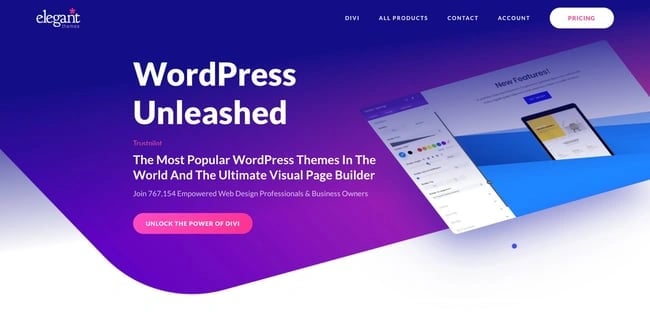
3. Themify
Themify is a strong contender in the WordPress theme framework space. It’s known for its intuitive drag-and-drop website builder, which makes it easy for any user to create a unique site after a little practice. Themify is another low-code solution with a highly visual building experience.
The possibilities are virtually unlimited with this framework, as users can customize every element of the site, from elements to layouts, just by changing the settings in the background. The builder allows for a wide range of elements, plus design enhancers like parallax scrolling, animations, and a flexible, responsive grid system. There are also over 25 premium add-ons to tailor your theme exactly how you want.
Themify Builder powers all Themify WordPress themes. The builder itself is free but must be used in conjunction with a Themify theme. Individual themes start at $59, or you can join the Themify Master Club for $89 per year — this membership gets you all Themify themes, plugins, and builder add-ons. There’s also the option for lifetime access to the Master Club for a one-time purchase of $249.
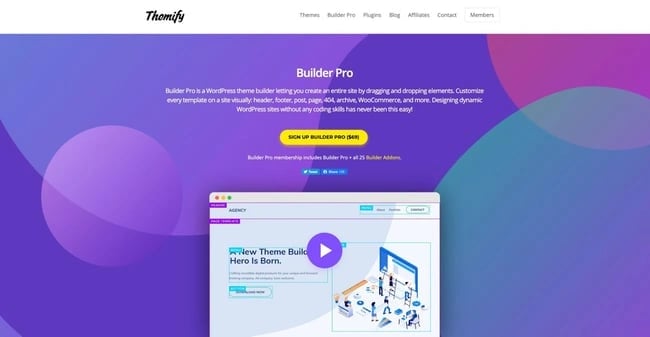
4. Ignition
The Ignition Framework was built by established theme developers over at CSSIgniter. Their combined experience has resulted in a flexible, robust and very easy to use theme framework, "without the confusing parts" as their motto goes. The framework comes in the form of a complementary plugin along with any one of its more than 50 framework-based themes.
This framework offers dozens of customization options, layout options for the entire site, and individually for the header, footer, blog listing, and single posts and pages. It also allows for full- and fine-grained control of a site's color scheme and typography. All custom post types, custom fields, and other meta needed by the themes are bundled in making themes more streamlined and lightweight. Finally, the Ignition framework takes care of third-party plugin integrations like WooCommerce, WPML, and many more.
Ignition themes can be purchased individually, or in various bundles with a low-priced yearly subscription which includes usage on unlimited sites, free automatic updates with its custom updater plugin, and top-notch support. If you encounter any issues when using the framework — along with one of its themes — just let the team know and they'll be back to you with a solution in no time. A limited-time offer of a lifetime subscription is currently available if you love the product so much and want to always keep your sites up to date.
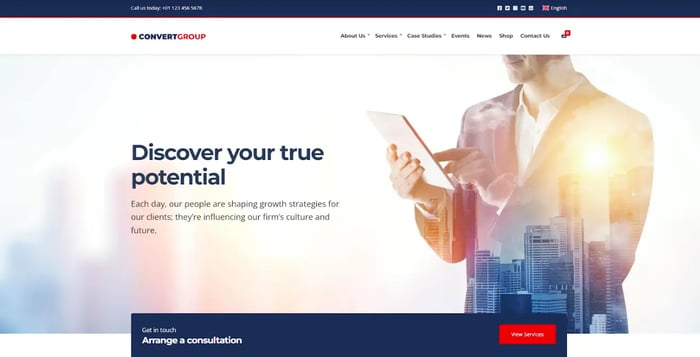
5. Vault
While Vault comes with 50+ of its own ready-made websites, it is also backed by the UiCore Framework plugin making it one of the most modern and flexible theme builders out there. With the Theme Builder, you’ll have complete control over your website elements without needing to learn how to code. The interactive design tools and features make it easy to build a professional website with just a few clicks, and you’ll never need to manually edit a theme file again. You will also get access to the UiCore Template Library, a collection of 500+ pre-designed sections and pages that can be easily added to your website.
Vault also comes with some other nifty features including full eCommerce support with the WooCommerce plugin integration, a visual form builder built with Elementor, a popup builder, and a dedicated support team to assist you with any questions.
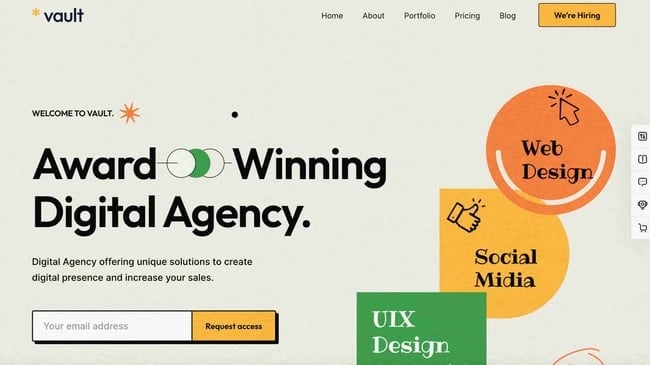
6. Gantry
If you’re looking for a free framework that’s relatively easy to get started with, consider downloading Gantry. This framework leverages a drag-and-drop interface called the layout manager to make the building experience simple and straightforward.
Inside the builder, you can access a library of widgets, or “particles” as Gantry calls them, each adding different functionality. These particles are for adding menus and mega menus, images and icons, sliders, and more to your theme.
Gantry can be downloaded by itself, but it must be used with a child theme. There are two themes offered on the website for free, Helium and Hydrogen. The developers recommend starting with Helium, and getting started is easy if you follow the framework’s thorough documentation.
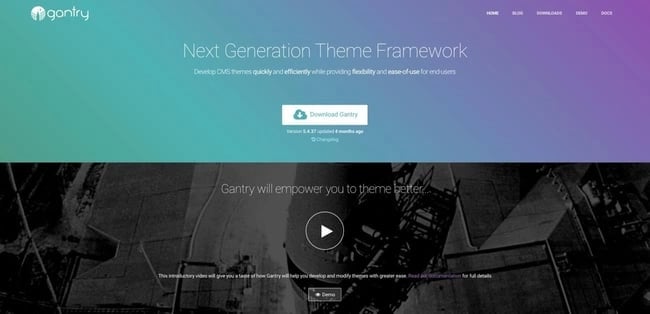
7. Cherry Framework
Cherry Framework is best for WordPress developers comfortable with delving into the code of their projects. It’s a free and well-known framework developed by Template Monster, designed to be both DIY and approachable for new and experienced developers alike.
Cherry Framework is built with Bootstrap CSS to ensure responsiveness on mobile devices, and receive regular updates to stay secure and high-performing. It also comes with built-in version control, so your themes continue to function well after every update.
While you can code custom elements from scratch, Cherry also lets developers place page elements and make design changes with shortcodes. This saves you time as you build out your themes while giving you tight control over where your elements are placed relative to each other.
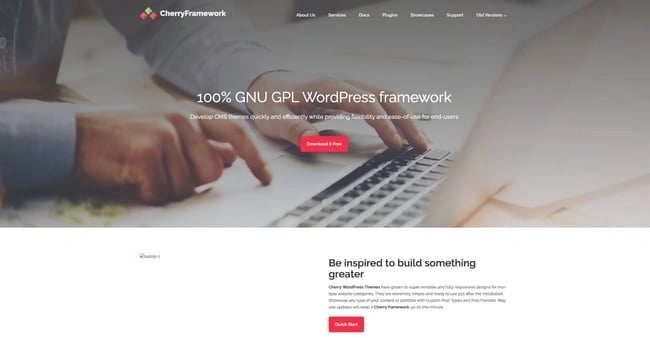
8. Headway
Headway is another powerful WordPress theme framework. Based on a drag-and-drop layout builder this framework makes it possible to create beautiful-looking designs in relatively little time. It’s easy to use and no-code: Just choose your template, customize the design, add content, and your theme is ready to go.
To start, drop your page elements into place inside Headway’s grid system — there are content blocks for many common site features. Then, refine your page elements with the Design Editor, which lets you change colors, borders, fonts, and virtually any other style aspect.
Headway is a premium WordPress theme framework. To get Headway, you can purchase a Standard license ($89), which gets you support and updates for three sites for one year, plus one template. You can also purchase the Deluxe license ($200) for one year of support and updates on unlimited sites, all templates, and the premium community builder block.
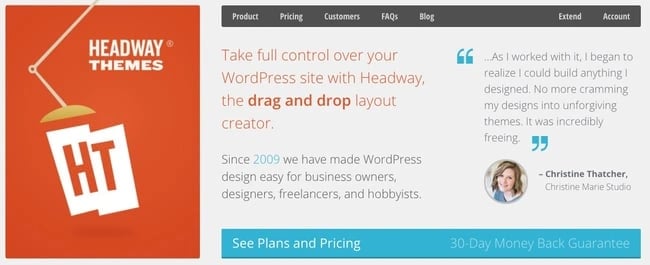
9. Hybrid Core
Hybrid Core is a free and open-source WordPress theme framework for WordPress theme developers. Hybrid Core’s mission is clear from the start: It doesn’t force you to create themes in any certain way — you can decide what you want to build, and you're in control.
Hybrid Core is ideal for building fully unique sites without relying extensively on pre-built templates or dragging-and-dropping. Instead, this theme framework is for experienced developers comfortable with every aspect of theme development. Notable features include its font loader for adding custom fonts and integrating Google Fonts, its media grabber for embedding media content from any source, and a template system that removes the limitations of the default WordPress templates.
While free to use, purchasing a plan grants access to a support forum. Depending on your plan, you get other premium features to aid your development. Hybrid Core’s plans are Exhale Pro ($49.99 per year), Members Pro ($59.99 per year), and the All-Access Bundle ($89.99 per year).
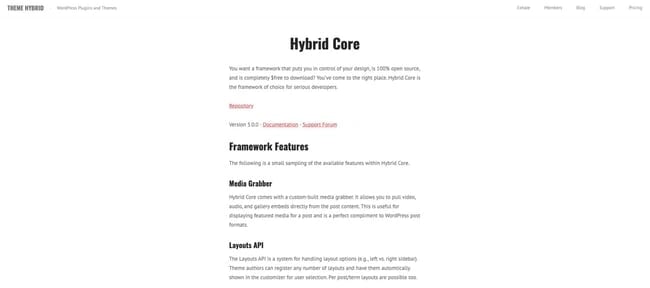
10. iThemes Builder
iThemes Builder is another framework accessible to WordPress users who might not know how to code, but still want to pursue a custom theme design. It provides users with the main builder, plus multiple (possibly over 100 based on your plan) child themes so you don’t need to start from scratch. iThemes also provides a Style Manager plugin to make quick, basic style changes in your theme.
The builder itself provides the flexibility to use headers, images, navigation, content areas, footers, and more without a line of code. Its layouts are fully responsive as well, and the builder interface itself is stripped-back — new users are less likely to be overwhelmed by options because of this, but they won’t see the same flexibility as other builders covered here.
iThemes Builder is priced on three levels: Foundation Pack ($80 for six child themes), Developer Pack ($150 for all 100+ Builder themes and two bonus plugins), and All Access Pass ($197 for all Builder themes, 80 classic themes, and two bonus plugins). All options come with one year of support and updates.
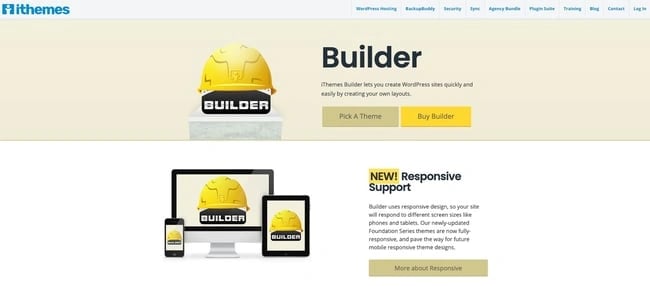
11. Thesis
Developer DIYthemes sells the Focus WordPress theme, a fast, lightweight option for high-performing WordPress sites. Included with this theme is the modular design system Thesis, which can do the work of a theme framework. It lets you build themes with a simple visual interface.
If you have HTML knowledge, you can build custom modules, then manipulate them in the framework like you would any other. Or, you can import pre-written modules and add them to your layouts. These elements can be saved and used in future designs, too.
As mentioned, you must purchase the Focus theme to gain access to the Thesis builder. Focus is priced at $87 per year for use on one site, $187 per year for five sites, and $297 per year for 20 sites.
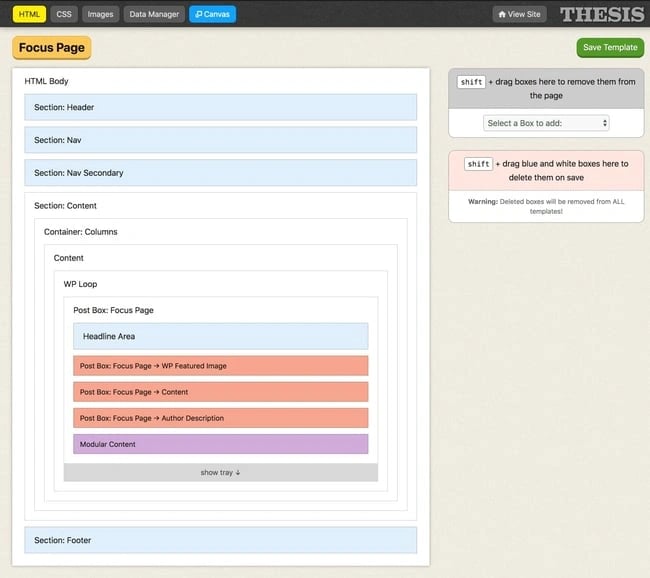
11. WPZoom
WPZoom is another well-known theme developer that uses its own Zoom theme framework for all its themes. You can’t purchase the framework on its own, but you can enjoy its benefits by installing one of WPZoom’s themes, which you can then modify to make yours.
The framework allows users to make easy updates to their themes and install widgets, plus includes import and export options and easy customization via the theme control panel included with every WPZoom theme. In addition, the framework is well-coded, SEO friendly, and produces fully responsive pages.
WPZoom themes are $79 each, or you can purchase a package of all themes starting at $99 per year, or make a one-time payment of $299 for a lifetime membership.
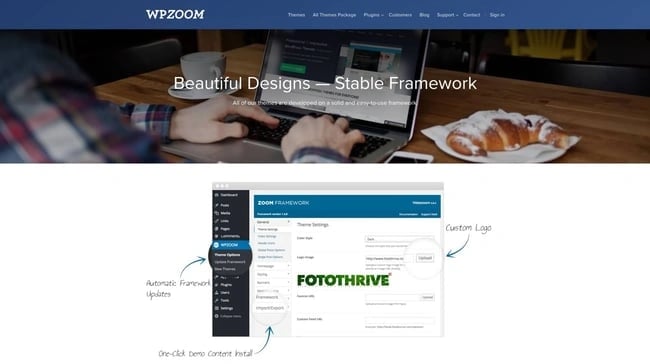
Can’t find a theme? Build one.
WordPress theme frameworks are one of the more advanced concepts in the WordPress space, and ideal for mid-level to experienced website owners who don’t want to settle for a pre-built theme.
Sure, using one will take more time, cost a bit more, and require some expertise. But, theme frameworks release much of the limitations associated with themes to help you construct the exact site you want. If you think it’s worth it, give any of the above options a go.
Editor's note: This post was originally published in January 2020 and has been updated for comprehensiveness.
WordPress Themes






